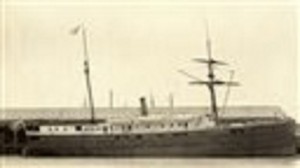SAN FRANCISCO, California — A dense fog enveloped the iron and wood steamship City of Chester and its 106 passengers as they began the slow journey north from San Francisco Bay to Eureka.
It was 1888, and family members bid their loved ones safe passage from the Broadway dock as the vessel disappeared into the pea soup fog.
Moments later, the Chester was split in two by a ship more than twice its size, killing 16 people — 13 passengers, including two children, and three crew members — and becoming the bay’s second-worst maritime disaster.
Now, more than a century later, a National Oceanic and Atmospheric Administration team has found the shipwreck. The team came upon the wreckage in 217 feet (66 meters) of water just inside the Golden Gate while it was charting shipping channels.
The crew used sonic imaging equipment to capture new three-dimensional images of the wreckage that will be released on Wednesday.
“Using a multi-beam sonar system, crews got nice three-dimensional sound pictures of the bottom that showed a wreck sitting upright,” said James Delgado, a NOAA shipwreck researcher and archaeologist who was chief scientist for the 2010 mapping of the Titanic.
The NOAA researchers then set to putting together research about what happened, and found tons of newspaper articles and transcripts of testimony from the accident investigation.
Delgado said newspapers at the time put much of the blame for the deaths on the crew of the immigrant steamer, the Oceanic, which survived the ordeal with a few dents in its hull.
Yet, NOAA scientists say much of the newspaper coverage failed to include witnessed accounts of heroism, and that the official investigation faulted the Chester’s skipper with the accident.
“The papers initially reacted, talking about the tragedy and accusations that the Chinese crew stood by and let people drown,” Delgado said. “But what happens is you start to see things also come out … countering that. Some leapt in water to save a drowning child.”
While there was a thick fog when the Chester set off, research showed the seas were calm. But there was a big incoming tide, which created a rip current off Fort Point near the mouth of the bay, which affected the Chester’s ability to move quickly.
The two ships spotted each other when they were about a half-mile apart but failed to reverse their engines in time.
The Oceanic’s bow went 10 feet (3 meters) into the hull of the Chester, and the Oceanic’s captain kept some momentum in the ship to keep the hole plugged in an effort to give people a chance to escape.
Still, five or six minutes later, the Chester was gone.
“The Oceanic crew was up on the bow reaching down to survivors on the Chester, lifting them on the deck,” said Robert Schwemmer, NOAA’s West Coast regional maritime heritage coordinator. “After the collision, in five or six minutes, the Oceanic crew went on to save a lot of people.”
A display with the shipwreck’s history and new images will be unveiled at San Francisco’s Chrissy Field, which looks out over the spot where the Chester sunk, just in front of the Golden Gate Bridge.
